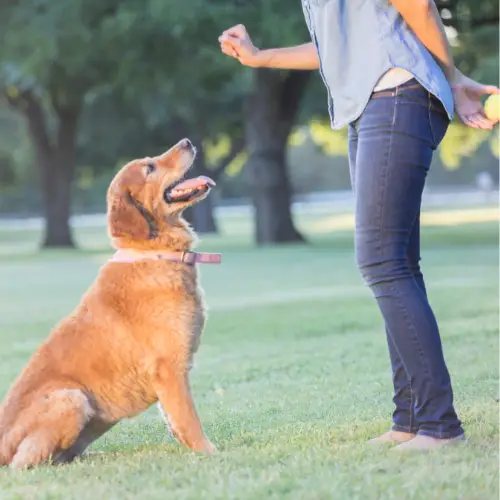Pawscessories is reader-supported. When you buy via links on our site, we may earn an affiliate commission at no cost to you.
Learn more.
Does your dog lack focus and always seem to get distracted by everything around rather than paying attention to you? Do you find yourself saying “my dog doesn’t listen to me, what am I doing wrong”?
Well, you’re not alone..
This is a major problem for many dog owners and it can be quite a nuisance when they simply won’t listen to you.
So how can you develop focus and get your dog to start listening and paying attention to you, even with distractions? Are their any dog training solutions?
In this post we reveal:
- 11 reasons your dog lacks focus, won’t listen & is easily distracted
- The dangers associated with a dogs that won’t listen
- Top tips to ensure your dog listens & never gets distracted again
Let’s dive in.
Table of Contents

11 Reasons Why Your Dog Doesn’t Listen + How To Fix It
1) Low Positive Reinforcement Rate
When there are distractions around, your dog may find looking around, barking at other dogs or people, and pulling the leash more rewarding than listening to you.
Why are dogs like this?
Well it’s likely because these “distractions” are more interesting and provide more entertainment than paying attention to you.
This is more so important in the early stages of training since they have very little experience listening to you.
Solution:
In order to make focusing on you more appealing, increase the rate of reinforcement. This will make them more interested in paying attention.
All you need to do is give your dog more HIGH valued treats (more on this later) in your training every time they do something good.
A low reinforcement rate (infrequent treating) will lead to your dog getting frustrated, losing focus, and becoming easily distracted by anything else.
Remember, early stages of training need continuous reinforcement after every single successful behavior.
Only once your dog starts to show signs of focus and obedience can you move to reduce the reinforcement rate.
You may want to consider enrolling in SpiritDog Training’s Perfect Focus Bundle — After looking at dozens of different programs to help with focus this is by far the best.
She has over 32,226 students across her trainings with 100% satisfaction.
You get lifetime access to professional dog trainers, on demand step by step video training, instructional PDFs, progress tracking, all from the comfort of your home.
So go ahead, try out SpiritDog’s Perfect Focus Bundle at no risk with their 60-day money back guarantee.
2) Using Low Value Treats
This might seem obvious but if your dog doesn’t listen it’s likely they don’t consider it “worthwhile” so it will be difficult to get your dog to listen.
The classic line many dog trainers use is “what’s in it for them?”.
The proper treats and rewards can makes the difference between a well behaved dog and a terror.
Solution:
Low value treats like kibble may not get your dog excited enough. You’ll be able to tell by their level of excitement when you bring out the treats.
Try using treats that are soft, smelly, and in small bite-sized pieces. An example would be pieces of cooked chicken breast.

They can be eaten quickly and are far more valuable than kibble.
Another great treat is what Dr. Ian Dunbar calls the Ferrari of dog treats: Freeze-dried liver.
The more valuable the treat, the more likely your dog will stay attentive to you rather than the distractions around them.
3) Conflicting Cues
Is your dog always given the exact same command every time they’re being trained?
Sometimes dogs are raised around a number of different people. Many of which use different commands for training.
Consistency is key when training your pup. If your commands and body language aren’t consistent they may become confused and frustrated.
This then leads to your dog not listening or focusing on you.
Solution:
Keep everything consistent. This means making sure everyone in the family is on the same page.
It also means trying to keep verbal and non verbal cues the same. If you use the verbal cue with patting your leg every time you say “come” continue to do this every time.
Also, try your best to only say the verbal cue one time. Otherwise your dog may learn not to listen to the first time you say it.
So in summary stick to the same verbal cue and body language cue every time you ask them the came command.
4) Lack Of Training
Although no one likes to admit the fault might be their own, dogs that lack focus usually have had improper training.
If their training is inconsistent, there’s no follow through on commands, you’re not firm with poor behavior, or they get improper reinforcement, this all leads to a pup that lacks focus.
Dogs are incredibly cute and people often let them get away with too much which can lead to disobedience.
If your pup has never been properly trained and has primarily done whatever they want whenever they want, all stages of learning are much more difficult.
Solution:
The fix is simple.
Start training your dog consistently.
You need to show your pup you’re the most interesting thing on the planet and when you can get your dog to listen great things happen to them.
If you’re someone who has trouble coming up with and sticking to a training routine check out this post reviewing the best dog training courses.

5) Training With Too Many Distractions
The best way to train any dog is to do it when the only thing around is you!
That way there’s nothing to distract them from you. This easily makes you the most exciting thing since nothing else is around to distract them.
Dogs are much more likely to lack focus when too much is going on. Especially when they have yet to be trained to deal with distractions while maintaining focus on you.
Solution:
Train your dog in a quiet room with nothing else in the room. Once they’re successful listening to you in a quiet room, build from there.
You’ll want to gradually increase the amount of distractions present when training.
Once they’re good at listening without distractions you can move outside into the yard.
Then to your local park or outside in front of your house. And eventually you’ll be able to even take them to the dog park and have them still listen.
If you start outside or in the middle of your house while there are distractions like kids running around, it’s going to be difficult to build a foundation.
6) Frustration Build Up
Dogs have mastered the art of analyzing body language. When you get frustrated or annoyed, your dog can tell.
This may lead some to lose focus, completely shut down and become much less obedient.
Solution:
If you notice you’re becoming frustrated do your best to end your training session with a win.
Get your dog to do a simple command, reward them, then end the session.
Go back later and try breaking the training sessions into smaller chunks of time.
This can help improve the training experience both for you and your pup.
Avoid raising your voice, bending down, or getting in their face, this can make your dog feel intimidated which can lead them to ignore your commands.
7) Overdoing It
It’s tempting to test your dog’s ability to learn by lumping multiple things together all at once.
Oftentimes getting a dog to listen to commands and stay focused is hard for them because what you’re asking is too hard for them to comprehend.
So your dog won’t listen because your dog training is too tough.
Solution:
Avoid ramping up the difficulty of your training too quickly.
Instead, the best thing to do is break down the objective/command into several mini steps to help your dog succeed with ease.
Avoid making training sessions too long and stick to short sessions. You’ll get a feel for the ideal length of time for your dog through repetition.
You’ll be able to tell when your dog is starting to lose focus because tasks become harder and they may appear anxious.
Try to end sessions before this happens.
Recommendation: If you feel like you struggle with knowing the right dog training methods here’s a simple 10-minute/day training routine that may help.
8) Emotional Issues
Fear, overwhelm/overstimulated, anxiety, stress, are all emotional states that may interfere with your dog’s focus.
Dogs stuck in a negative emotional state will have issues with listening which impairs their ability to learn.
Do you remember the last time you tried learning something when you were scared or stressed out?
Probably not! That’s because it’s very difficult to learn in an emotional state. It’s the same for dogs.
Solution:
In these cases you need to find places where your dog is less likely to be pushed into an emotional state that may interfere with their focus on you.
For example, if your dog is scared of loud noises, make sure you don’t train them in an area where loud noises can happen.
This can be applied to positive emotions also.
If your pup gets over excited when other people are around, make sure to be in a quiet place with just the two of you when training.
Once you’ve developed some foundational training, you can then move them into areas with more people or potential distractions.
The key here is understanding why your dog is having this emotional response and adjusting accordingly.
9) Health Problems
It’s usually not very obvious when your dog is in pain or discomfort, some can hide it pretty well.
Only when the pain becomes unbearable would they show you.
If your dog is ignoring your commands but usually doesn’t, make sure to rule out any medical issues.
Dogs can lack focus when they’re in pain/discomfort.
Solution:
If you have a hunch that your dog may be in some form of discomfort talk with a vet to rule out any health related problems.
Nothing brings peace of mind quite like speaking with a vet, you can click here to chat with a vet online right now.
Aside from medical issues, some dogs have preferences on circumstances for training.
For example, if you’re trying to get your dog to focus on a hot summer day, this might make it hard too for them to focus.
10) Boredom

For dogs an “idle mind is the devil’s workshop”.
One simple secret to a well trained dog is to engage their mind and get them thinking.
Dogs actively WANT to work, and when they don’t, they can become destructive, disobedience, and develop poor mental health.
Solution:
Make sure you’re actively stimulating your pup’s mind throughout the day.
The easiest ways you can stimulate your dog’s mind is through training, walks/exercise, and puzzle toys.
You can check out our list of mind stimulating toys that are great for those days you’re running low on time.
11) Improper Training
Many dog owners think their dog is ignoring them and getting distracted because they’re being spiteful.
Some like to throw the ‘dominant’ card around. “My dog is an alpha, that’s why he doesn’t listen and does what he wants”.
In reality dogs aren’t capable of being spiteful and dominance is usually not the issue when it comes to getting your dog to focus and listen to you.
Other people will say “my dog is just hyper.”
The truth is labeling your pup in this way is usually an excuse for not taking the time necessary to train them properly.
Solution:
Dogs perform behaviors which produce positive outcomes (positive in their minds), that’s the only reason for their actions.
This is known as reinforcement because a dog’s behavior produces a positive result and that behavior solidifies as it’s repeated.
So, in order to make sure your dog listens to you, it’s crucial to create positive associations when they do listen.
It’s also important to avoid making the mistake of labeling your dog as an excuse for their lack of attention and obedience.
Having a focused dog that is obedient means having a dog that comes when called, listens to you outside and in public areas, is always calm, and isn’t reactive.
How Do You Discipline A Dog That Doesn’t Listen?
If your dog isn’t listening to you, it’s important to figure out why before you start trying to discipline them. Once you know the reason, you can discipline a dog that doesn’t listen with positive reinforcement and/or a punishment that is appropriate for the situation.
The best way to discpline a dog is through negative reinforcement. However, I would stay away from using methods that cause physcial pain. For me the best punishment for training a dog that won’t listen is isolation.
Anytime this misbehave and dont listen, they get isolated. Overtime they learn that if they want to avoid being isolated and continue to play they must listen.
How Do I Get My Stubborn Dog To Listen?
There are a number of ways to get a stubborn dog to listen. The most important thing is to be consistent with your commands and make sure that your dog understands what you’re asking them to do.
One way to get a stubborn dog to listen is to make sure you are always using irresistable treats. For example, if your dog loves chicken, only give them chicken when they listen to you. This way, they will always associate listening to you with getting something they want.
If treats don’t work find their highest valued item or thing and only give them it when they listen. For example, if your dog loves a certain toy, only give them the toy after they listen.
What To Do When Your Dog Ignores Your Commands?
If your dog is ignoring your commands, the first thing you need to do is figure out why. They may be distracted, cannot hear you, they may not be motivated, or they may simply don’t understand what you’re asking them to do.
Once you know the reason, you can work toward solving the issue and getting your dog to listen.
The Dangers Of Having a Dog Who Won’t Listen
If you find yourself with a dog that doesn’t listen to you, I’d like to share with you a personal story about my old dog Elena.
It was that time of year where the leaves were just starting to change color.
I was 13 years old and outside with our puppy, Elena.
I was raking the leaves.
Elena was jumping in the leaf piles and making a mess.
I decided to take a break from raking so I leaned my rake up against an old oak tree and went to grab Elena’s leash.
We were getting close to having Elena fully house trained.
But, she still wouldn’t come when called and was having a lot of trouble doing what she was told.
I wanted to see how well she could walk beside me without holding the leash. I’d be right beside her watching and if she got excited I’d just stomp on her leash.
A simple plan that sounded foolproof to a 13 year old boy. It was going surprisingly well for about 10 minutes. Then my brother came running outside. It distracted me and got Elena’s attention.
She ran after him.
I stomped, missed.
Stomped again, missed.
As a last stitch effort I ran and lunged forward to try and grab her leash.
But I missed again.
She was on the loose.
She had gotten out in the front before, but for some reason this time was different.
Every time I got close to her she’d run further away.
For 20 minutes I was doing everything I could to catch her. But she was too fast and wouldn’t listen.
I was starting to get worried because she was getting closer and closer to a high traffic road.
Which made me start to panic.
The more I tried to grab her, the more she thought it was a game and the further she ran away.
My heart was beating out of my chest.
I was tired.
I was frustrated.
And I was starting to get really worried.
Then.. the worst possible thing happened.
A car drove by and Elena started to chase after it. I was chasing after her on the side of the road.
I then saw another car coming up behind the one Elena was chasing.
I shouted, “No! Stop! Stop your car!”
But it was too late.
It made contact with Elena.
And she was gone.
Just like that.
I share this terrible story with you because I wish I had taken more time to train her. I wish I had the right information to be a better owner.
I wish I had more time with her.
Most importantly, I don’t want you to ever experience this horrible event.
Which is the reason why I did my best to make this post as thorough and action-based as possible. When a dog won’t listen to you it can be dangerous. So here I will share why dogs don’t listen, how to get your puppy to listen to you, and everything in between.
Final Thoughts
There are many reasons a dog doesn’t listen to you.
Remember, don’t label your dog as stubborn or hyper and don’t yell or punish them like a drill sergeant.
Be patient, persistent and do your best to identify why they’re behaving the way they are. Then you’ll be able to better understand and train them.
Other posts you might find interesting:
7 Simple Steps To Get Your Dog To Stop Barking
